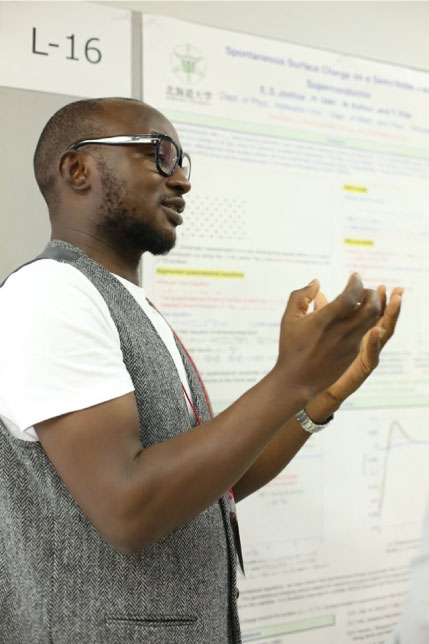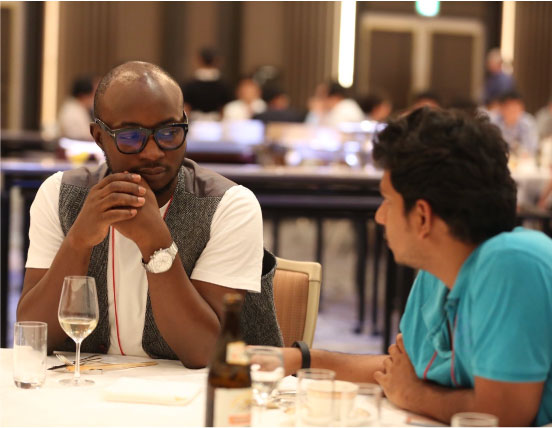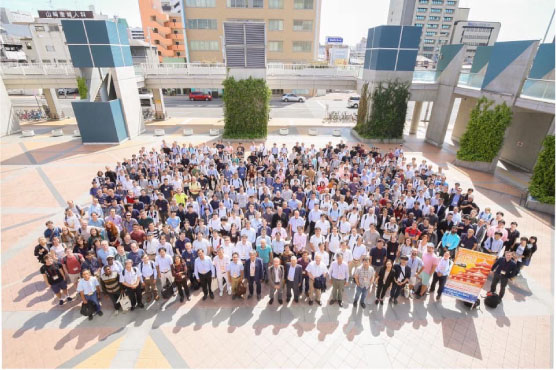|
|

|
国際学会体験談(Joshua Ezekiel Samboさん@統計物理学研究室)
|
 I attended SCES 2019 held at the Okayama Convention Center, Okayama city, from September 23rd-28th, 2019 (see http://sces2019.org). SCES 2019 is a continuation of a series of SCES conferences which was first held in Sendai in the year 1992, with SCES 2018 held in San Francisco USA, the next (SCES 2020) scheduled to hold in Guaruja-SP-Brazil (see https://sces2020.org). This annual conference brings together theoretical and experimental researchers in various fields relating to strongly correlated materials, with a large number of carefully selected invited talks from leading researchers and also numerous plenary sessions. SCES 2019 had about 800 participants, about 400 of which came from outside Japan.
At SCES 2019, I had the invaluable opportunity of talking to many people about my research on surface charging in superconductors, with the title "Spontaneous Surface Charge on a Semi-finite d-wave Superconductor". I talked about the accumulation of electric charge near the surface of a model unconventional superconductor, based on the augmented quasiclassical theory. The model system is suitable for understanding the redistribution of electric charge near the surfaces of both hole-doped cuprates such as and electron-doped cuprates such as .
I attended SCES 2019 held at the Okayama Convention Center, Okayama city, from September 23rd-28th, 2019 (see http://sces2019.org). SCES 2019 is a continuation of a series of SCES conferences which was first held in Sendai in the year 1992, with SCES 2018 held in San Francisco USA, the next (SCES 2020) scheduled to hold in Guaruja-SP-Brazil (see https://sces2020.org). This annual conference brings together theoretical and experimental researchers in various fields relating to strongly correlated materials, with a large number of carefully selected invited talks from leading researchers and also numerous plenary sessions. SCES 2019 had about 800 participants, about 400 of which came from outside Japan.
At SCES 2019, I had the invaluable opportunity of talking to many people about my research on surface charging in superconductors, with the title "Spontaneous Surface Charge on a Semi-finite d-wave Superconductor". I talked about the accumulation of electric charge near the surface of a model unconventional superconductor, based on the augmented quasiclassical theory. The model system is suitable for understanding the redistribution of electric charge near the surfaces of both hole-doped cuprates such as and electron-doped cuprates such as .
 The underlying mechanism is as follows; when a -wave superconductor is cut along the [110] direction such that it has a specular boundary with vacuum (also applicable to rough boundaries), electric
charge accumulates near the surface of the superconductor, due to the suppression of its energy gap. This charge modulation occurs notwithstanding the absence of magnetic field.
It was so exciting talking to other researchers about my research, especially to experimentalist, on the possible techniques for observing surface charging
in superconductors. I also got new insights from the discussions I had with other theoretical researchers. Explaining my research to many times at the poster session further enhanced my understanding of the subject itself.
The invited talks, other presentations at the plenary sessions as well as the poster sessions also helped me understand the connection between my research and those of other people, and also gave me new insights about my future research aspirations.
In addition to the plenary and poster sessions, other events at the conference included an opening ceremony on the day of arrival and a banquet held on September 26th. The banquet provided additional opportunity to socialize and to talk about science over a glass of drink and a plate of delicious food.
The underlying mechanism is as follows; when a -wave superconductor is cut along the [110] direction such that it has a specular boundary with vacuum (also applicable to rough boundaries), electric
charge accumulates near the surface of the superconductor, due to the suppression of its energy gap. This charge modulation occurs notwithstanding the absence of magnetic field.
It was so exciting talking to other researchers about my research, especially to experimentalist, on the possible techniques for observing surface charging
in superconductors. I also got new insights from the discussions I had with other theoretical researchers. Explaining my research to many times at the poster session further enhanced my understanding of the subject itself.
The invited talks, other presentations at the plenary sessions as well as the poster sessions also helped me understand the connection between my research and those of other people, and also gave me new insights about my future research aspirations.
In addition to the plenary and poster sessions, other events at the conference included an opening ceremony on the day of arrival and a banquet held on September 26th. The banquet provided additional opportunity to socialize and to talk about science over a glass of drink and a plate of delicious food.
|
 My recommendation to other students and young researchers is as follows; go out! Out of your research room if you can, out of Sapporo if you can, out of Hokkaido if you can, out of Japan if you can, out of Asia if you can, and go out of our planet if you can, talk about your research and learn about what other people are doing.
My recommendation to other students and young researchers is as follows; go out! Out of your research room if you can, out of Sapporo if you can, out of Hokkaido if you can, out of Japan if you can, out of Asia if you can, and go out of our planet if you can, talk about your research and learn about what other people are doing.
|
|

